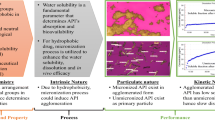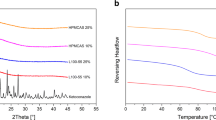Abstract
Purpose. Since a previous qualitative study carried out by us showed the existence of an important influence of the particle size on the percolation thresholds and taking into account that the existing theoretical models can only provide qualitative explanation to this influence, the purpose of this work is to carry out the first quantitative study of the influence of the particle size over the drug percolation thresholds.
Methods. Matrix tablets have been elaborated using potassium chloride as drug model and Eudragit RS-PM as matrix forming material. Five different KC1 particle size fractions have been employed whereas the Eudragit® RS-PM particle size was kept constant. In-vitro release assays were carried out for all the elaborated lots. The drug percolation thresholds were estimated following the method proposed by Bonny and Leuenberger.
Results. A linear relationship has been found between the drug particle size and the corresponding drug percolation threshold.
Conclusions. This finding confirms the results previously obtained in our qualitative study and has important repercussions in the design of pharmaceutical solid dosage forms. If this linear behaviour is general, the percolation threshold can soon become a useful preformulation parameter.
Similar content being viewed by others
REFERENCES
J. M. Hammersley. Percolation processes. Lower bounds for the critical probability. Ann. Math. Statist. 28:790–795 (1957).
H. Leuenberger, B. D. Rohera and C. Haas. Percolation theory—a novel approach to solid dosage form design. Int. J. Pharm. 38:109–115 (1987).
J. D. Bonny and H. Leuenberger. Matrix type controlled release systems: I. Effect of percolation on drug dissolution kinetics. Pharm. Acta Helv. 66:160–164 (1991).
D. Blattner, M. Kolb and H. Leuenberger. Percolation theory and compactibility of binary powder systems. Pharm. Res. 7:113–117 (1990).
I. Caraballo, M. Fernández-Arévalo, M. A. Holgado and A. M. Rabasco. Percolation theory: application to the study of the release behaviour from inert matrix systems. Int. J. Pharm. 96:175–181 (1993).
J. D. Bonny and H. Leuenberger. Matrix type controlled release systems. II. Percolation effects in non-swellable matrices. Pharm. Acta Helv. 68:25–33 (1993).
I. Caraballo, M. Fernández-Arévalo, M. A. Holgado, A. M. Rabasco and H. Leuenberger. Study of the release mechanism of carteolol inert matrix tablets on the basis of Percolation Theory. Int. J. Pharm. 109:229–236 (1994).
D. Stauffer and A. Aharony. Introduction to Percolation Theory, 2nd ed., Burgess Science Press, London, 1991.
J. E. Hastedt and J. L. Wright. Diffusion in porous materials above the percolation threshold. Pharm. Res. 7:893–901 (1990).
A. Coniglio. Some cluster-size and percolation problems for interacting spins. Phys. Rev. B 13:2194–2207 (1976).
G. Yu. Correlated Percolation in solid solutions with short-range order. Philosoph. Magazine B 69:95–101 (1994).
S. Prakash, S. Havlin, M. Schwartz and H. E. Stanley. Structural and dynamical properties of long-range correlated percolation. Phys. Rev. A 46:1724–1727 (1992).
A. Patrascioiu and E. Seiler. Critical behaviour in a model of Correlated Percolation. J. Stat. Phys. 69:55–65 (1992).
I. Caraballo. Teoría de la Percolación: aplicación al diseño y caracterización de sistemas de liberación controlada de medicamentos. Ph. D. Thesis, University of Seville (1994).
C. C. Yeung and J. A. Hersey. Ordered powder mixing of coarse and fine particulate systems. Powder Technol. 22:127–133 (1979).
Author information
Authors and Affiliations
Rights and permissions
About this article
Cite this article
Caraballo, I., Millan, M. & Rabasco, A.M. Relationship Between Drug Percolation Threshold and Particle Size in Matrix Tablets. Pharm Res 13, 387–390 (1996). https://doi.org/10.1023/A:1016088424993
Issue Date:
DOI: https://doi.org/10.1023/A:1016088424993




